#one queue three
Text


cute crispy critter
Atomic Heart 4/? - Limbo
#atomic heart#atomic heart screenshots#virtual photography#danyasceenshots#limbo#screenshots#atomic heart game#crispy critters#i just love this creature#one queue three
55 notes
·
View notes
Text
"why should I get invested in shows if they'll just get canceled" I was deeply invested in Heroes (2006) and it was not canceled, it just got really terrible. I also got really invested in the sandwich I had a few weeks ago despite it only lasting like 15 minutes. You must embrace the ephemeral. You must be willing to love things that may not love you back, that might betray you, or that may die an untimely death. As the great philosopher Mr. Mitchell Lee Hedberg said "I'm not gonna stop doing something because of what happens at the end."
#now granted he did die of a drug overdose but you know. one can take the good lessons#anyway. point being i understand being deeply frustrated with the state of the tv and film.#but also we can admit that for every gem canceled there's like three real duds too#idk if you want something that's guaranteed to have a bunch of seasons and you know the ending for go watch shows from the 70s#the number of adults on this site who lack the emotional wherewithal to watch an ongoing narrative is. yikes.#queue
14K notes
·
View notes
Text


so i draw trash once a year JUST KIDDING APRIL FOOLSSSS
#hello i havent been on here in months but thats abt to change babeyyyy#(going to queue up three dozen posts bc ive been drawingggggg)#and i finally have the confidence to share againnnnn#(and i mean it this time bc ive been posting on twittterr all monttthhh)#my art#what do i tag this....#g/t vore#mouthplay#safe vore#first one was a year ago for a friend (i was bullied)#second one is over a month ago for a friend (i was bullied)
193 notes
·
View notes
Text
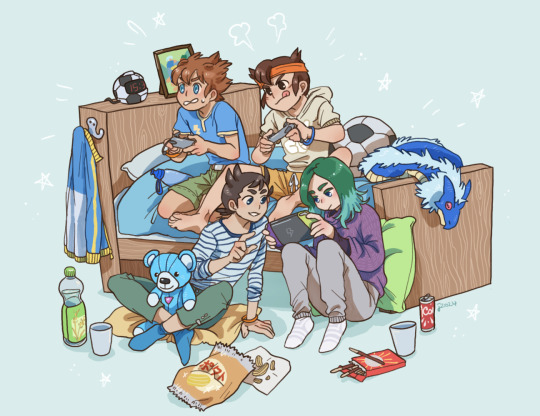
happy ina11VR beta test day!! have fun!
#inazuma eleven#inazuma eleven go#inazuma eleven ares#uh.. how do I tag ares/orion in one tag... sth to figure out later#inazuma eleven vr#so excited!!! finally new inazuma!!!#actually drew this like three hours before the beta date reveal but decided to queue for today lol#spot the secret 5th protagonist in the picture
183 notes
·
View notes
Photo







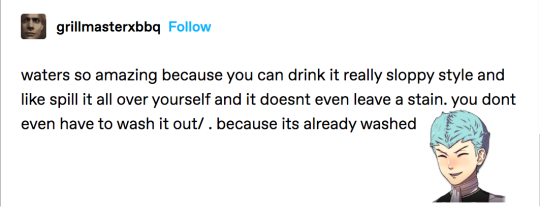
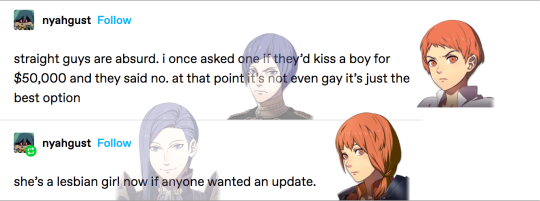

witty caption
#fire emblem three houses#caspar von bergliez#hilda valentine goneril#seteth#flayn#hubert von vestra#ferdinand von aegir#felix hugo fraldarius#dimitri von blaiddyd#dorothea arnault#balthus von albrecht#yuri leclerc#ashe ubert#lorenz hellman gloucester#leonie pinelli#claude von reigen#i think this is gonna be the last one i post where my the photo poster is going to be easy to use#cause it updated recently which gave me polls but made posting photos a maddening experience#anyway enjoy this dumb shit i will never stop#on my death bed i'll just queue a ton of these so you'll continue to be graced by them
572 notes
·
View notes
Note
Can I offer them a bunch of groceries? The idea of them running low on supplies worries me ;v;

Horror: FUCK- YEAH- I M ean- yeah. thank you. this is appreciated s'much thank you-
(Creator sidenote: i can't draw grocery bags)
#horror sans#food#groceries#Horror is trying to hold it together as one of three uninjured people but his fear of running out of food lingers#and Nightmare finally passed out after staying awake longer than he normally would#Horror and Dust have a lot on their metaphorical plates#Horror would be super happy if Cross would rest instead of moving around so much#i'd say the same for Killer but he can't walk so instead it's just the fact he keeps falling out of bed ghsdjkfhsd#the grocery bags are actually fairly big Horror is just Super Fucking Tall (TM)#queue
163 notes
·
View notes
Photo

IM NOT OKAY!!!
#revenge era#my chemical romance#gerard way#frank iero#mikey way#ray toro#mcr#three cheers for sweet revenge#redraw of that one scan from the mv photoshoot thingy wingy#if anyone cares thats my fave mcr album lalalala skips off into the sunset#queue are lovely
4K notes
·
View notes
Text

28/01/2024
stars don't twinkle moon doesn't shine
big thanks to @nahrgles for finishing this for me after i hit a wall with colors bg and effects- chromatic aberration blew my fkn mind
pre edit transparent version under cut because i spent too much time cleaning it loll

#sonic the hedgehog#sth#sonic#shadow the hedgehog#shadow#sonic adventure 2#sa2#admin draws#fanart#not intended as ship theyre kinda just There but like if ya wanna tag it i aint stopping you#never played sa2 myself but ive been insane about these two for saur long now and thats like half the reason i even finished this#finished sonic generations though and i replayed this fight like three times omgfgghgh its so fun. i love them so much#those who follow my main blog mightve seen the piece by a long deactivated artist that inspired this#queue spat it out just around the time i finished this#sitting down to complete a piece that i dont finish in one sitting is rare let alone 2 (it took 3) and im pretty happy with it#still not ttoooottally happy but you just gotta let mistakes be and not ruin ur perception of a thing thats on the whole. pretty good#ive still got a bg3 wip in the works but i might have to doodle these 2 for sanity rather than sitting down after a long day#of studying infectious diseases for a final. and then making myself work on something ive wrung of most of its initial creative dopamine#MORNING EDIT WOW. THAT TRAILER HUH. 20 YEARS OF SHADOW RETROSPECTIVE HOW WE FEELING.#BC I KNOW IM ON CLOUD NINE NOW
112 notes
·
View notes
Photo

wizard of the sky (again!!!!)
#pokemon#swsh#champion leon#reworked the sky wizard design because I wanted to proper it up. and it turned into an entirely different design#but! I prefer this one! there's thought put into this one!#can't fault the other one it was made during a 2hr break or something#also. how come I've put out there a buncha see-thru áo tấc and nhật bình and have yet to see anything return. why is no one making these#do I have to make these myself. I would! one of these days! thats a threat!#I need to eat chips n lay down now but I had fun doing this one :]#I will draw wizard leons for as long as I still have ideas of what kinda wizard to turn him into. there are like three in queue rn#its so dang fun doing these wah!!!#have a good night lads!! use hook to bring opponent into close quarter
845 notes
·
View notes
Photo








LOVE ON TOUR – Seoul (3/20)
Reading a fan’s sign/journal
#harry styles#gif#love on tour#erkay this is scheduled like three? hours after i fought with ps to finish it for funsies#by funsies... i mean my fear of the post button and inclination to hit queue instead but i also did not say that!!!#he did miss two not one though 😭 the 'can u check it' before the 'plz'
528 notes
·
View notes
Text

*takes a long drag from cigarette and stares into the distance with eyes that have seen a lot*
this scene, I tell ya
Atomic Heart 2/? - Twins
#atomic heart#atomic heart screenshots#virtual photography#danyasceenshots#atomic heart twins#ballerina twins#screenshot#atomic heart game#crispy critters#one queue three
24 notes
·
View notes
Text

"I'VE FINALLY FOUND THE PERFECT PHOTO THAT CAPTURES MY HANDSOMENESS, AND IT JUST SO HAPPENS TO BE FROM RIGHT WHEN MY BATTLE BODY WAS AT ITS ABSOLUTE NEWEST! I'M SURE YOU'RE ALL VERY, VERY JEALOUS, BUT PLEASE TRY TO CONTAIN THAT WITHIN YOURSELVES AND USE IT TO FUEL YOUR FUTURE ASPIRATIONS! MAYBE ONE DAY, THOUGH NOT TODAY, OR THE NEXT, OR THE ONE AFTER THAT, YOU WILL REACH MY UNFATHOMABLY NATURAL SENSE OF STYLE AND GRACE, BUT FOR NOW JUST FEEL THANKFUL THAT YOU HAVE THE OPPORTUNITY TO WITNESS SUCH AN AMAZING ACT OF GENEROSITY AND..."
#ASK EBONY#WEEK THREE#[end of queue AND week 3!]#[this next week will be THE FINAL ONE! so make it COUNT!!!]
56 notes
·
View notes
Text
Tropical Milkweed, Its Problems, and What To Plant Instead
I am writing this to atone for the sins of my past (handing out tropical milkweed cuttings to my friends and teachers before I knew better).
(Also let me make this clear I am Floridian I am writing this from the perspective of someone in the United States if you live in Tropical Milkweed's native range this doesn't apply to you go forth pogchamp)
Look online, on TV, in books, in newspapers, left, right, up, down, anywhere, and you'll see people talking about how planting milkweed is crucial, essential for the survival of monarch butterflies. Milkweed is the only plant that monarch caterpillars can eat as they're growing, and the loss of it in our wild spaces is one of the most direct links to the ecological extinction speedrun of not just monarchs, but dozens of other insects who rely on its abundance of nectar-filled flowers to survive. You'll be urged to run, not walk, to your nearest garden center, buy as much milkweed as you can, and hurry fast to plant it in your gardens and be part of the solution, not the problem. The issue is that, oftentimes, the milkweed you leave the store with is a vibrant red and orange, with pointed green leaves, dozens like it lining the shelves across stores all over the nation...
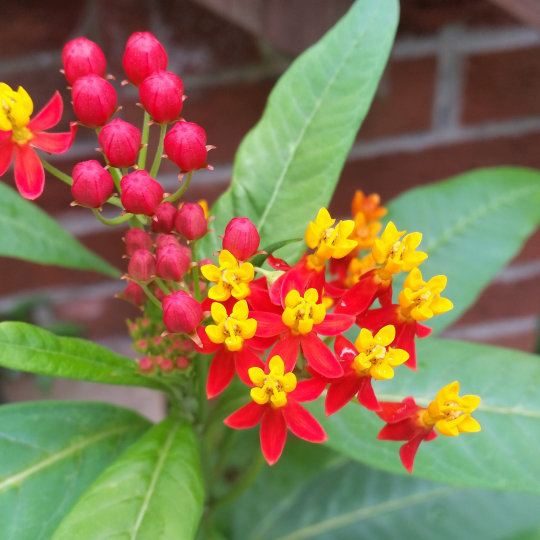
Tropical milkweed. Scarlet milkweed. Bloodflower. Mexican butterfly weed. Asclepias curassavica. This plant is a being of many names, and our culprit of the hour.
'Culprit? Culprit of what?' Culprit of enticing people to buy it under the guise of helping, only to possibly cause more harm than good.
Let's discuss.
Tropical Milkweed (Asclepias curassavica) is a gorgeous milkweed (especially the yellow variety? ooh, that had me in a grip as a teen) that's easy to obtain--too easy. It lines the shelves of stores like Walmart, Lowe's, Home Depot, and even hundreds and dozens of smaller garden stores, and is sold for reasonably cheap because its quick and easy to grow from seed and eagerly roots from cuttings. It's extremely popular with butterflies too--in many scenarios, Tropical Milkweed will be preferred as host plants over other related species like Butterflyweed (Asclepias tuberosa), and its also popular with other species of butterfly, bees, and wasps as a nectar source. It lasts well into winter in some areas of the United States, is quick to regrow when cut back, and doesn't die back for periods of the season like some other milkweeds do. It's eager to reseed, creating capsules with tens of dozens of seeds and scattering across the winds with the help of little silky parachutes much like the ones dandelions are known for.
'Ani, what's the problem with that? This all sounds like its great for monarchs!'
See, here's the kickers. In fact, here's several kickers. Here's an entire mollywhopping of kickers.
OE Infections
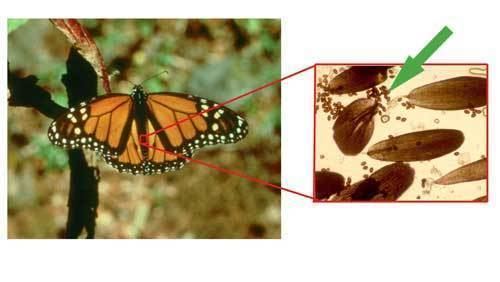
In the temperate areas that it doesn't die back over winter (or even, in some cases, where it doesn't die back during the season like other milkweeds), it can become a host for OE. OE is short for Ophryocystis elektroscirrha, and its a protozoan parasite that can and frequently does infect monarchs. As infected monarchs visit different plants--whether its to drink nectar, to lay eggs, or even just doing a fly-by of the garden--they drop spores from their wings that can then fall onto the leaves, flowers, and even any eggs already on the plant. As caterpillars hatch and begin to eat the plant, they ingest the protozoan, which begins the cycle anew. High OE levels in adult monarchs have been linked to lower migration success, reductions in body mass, lifespan, mating success, and flight ability. And that's if the caterpillars don't succumb prematurely to the infection, or if they're able to even exit their cocoon and fly once they finish pupating--deformed wings are frequently a result after infections. Now, OE is a parasite that's evolved alongside monarchs--and monarchs are usually able to handle an infection just fine, but if they're carrying a high load? That's where the problem lies.

What role does tropical milkweed play in this? Most milkweeds die back after blooming, at least once or even twice per season--and the parasite dies alongside them. As native milkweeds push out fresh foliage, its parasite-free, offering a healthy new buffet for caterpillars. Tropical milkweed... doesn't do that. If nothing's done, (at least in my state of Florida) tropical milkweed will stay fresh and green all the way up until the first real frost hits way in December--and that's if there's a hard frost, when you travel farther south. And during all that time, OE levels are building up on the leaves, so any future caterpillars that feed on this plant are doomed the instant their egg is laid on a leaf.
Its not that it's utterly impossible for a monarch to get infected with OE on any other kind of milkweed--monarchs are known for their traveling habits, and the chances of them happening upon a different milkweed plant than the tropical milkweed in your backyard is pretty high. But whereas native milkweeds die back and essentially reboot their system with fresh, disease-free leaves at least once a season, tropical milkweeds are like downloading a virus onto a USB and then passing it to your friends.
But that's not all, either. Time for kick 2.
Migration Interruption

Sit with me a moment and imagine you're a monarch butterfly. You're hardwired to know that as your food source starts dwindling at home, its time to get a move on and fly on down to the family's vacation home in Mexico for the winter. The buffets shut down, you exit stage left. But on your way to what's essentially a season-long smorgasbord with friends, you find... a buffet is still open. You're supposed to leave when the buffets are shutting down, but this one's up and running, lights are on, and plenty of people are there having fun, so you step in to relax. You'll take your trip later.
Now imagine a bit after you entered that buffet, the staff stuffed the guests into the walk-in freezer, locked the door, turned off all the lights, locked up the building, and left.
That's basically what tropical milkweed being 'evergreen' is doing to monarch butterflies in the fall and winter seasons. In areas up north where it can stay growing far later into the fall/winter months--or worse, in the south, where it can basically be evergreen until a hard frost (if one even happens), it can interrupt the monarchs' iconic migration cycle. They'll stay in place and continue breeding, living life like they aren't supposed to be a country away--until a frost hits, and they're dead in a snap. And if there's not a frost, you're getting a bunch of OE spore-ridden monarchs flying around a bunch of OE spore-ridden milkweed plants that the butterflies who followed the rules and overwintered in Mexico are gonna be returning to. POV you're starting a family in a house so laden with asbestos and black mold that there's practically black dust floating around.
This is already pretty bad. Can it get worse? Absolutely. Kick number 3.
It's Pretty Invasive (in the US)
It's fast growing, its eager to go to seed (so eager that it can flower and produce seed at the same time), its growing all throughout winter--which would be great, if it were native to the United States. Unfortunately, it isn't! As one could imply from the name, Mexican butterfly weed is native to--well--Mexico, as well as the Caribbean, South America, and Central America.
Further North into the states, and it's more of an annual--a plant that lasts maybe a year tops, dies back permanently, and you go buy more next year, or start from seed. Further south? It's a perennial, baby--which means its got even more time to spread its seeds and really thrive in the warmer climates of places like Florida, Texas, California, etc. Not to mention, as climate change makes temperatures rise, places where tropical milkweed is an annual may quickly begin seeing it stand strong all year...
I won't pretend to be a Professional Milkweed Identifier. I'm getting better at it with time, but I'm not a pro. But most of the time I go outside and I go 'oh, that's a milkweed!' its tropical milkweed. I've seen it grow in the sidewalk cracks of a gardening store I go to--its a clean four feet tall, always flowering, always making seeds. Tropical Milkweed is eager to escape the confines of your backyard, or make more plants in your backyard--I started with 5 plants one year, and the next year I had seven, then twelve, and that's just the ones that didn't get mowed over in the seedling stage...
But wait, that's not all! Kick number 4, baby!
Toxic to Monarchs????
According to the Xerces Foundation, emerging research suggests that tropical milkweed may become toxic to monarch caterpillars when exposed to the warmer temperatures associated with climate change.
'What the fuck, I thought milkweed was good for monarchs! How the hell does that happen?!'
All milkweeds produce cardenolides in their sap--a type of steroid that are toxic to most insects (and even people). Milkweeds create it to repel herbivores that would munch on it otherwise--except for milkweed butterflies (Danainae family), like our legendary monarch, as well as the queen and plain tiger butterfly. Larvae eat up milkweed leaves like there's no tomorrow, to stock up on those cardenolides and become toxic to their vertebrate predators--except for a few species that have evolved to become cardenolide-tolerant (black-backed orioles and black-headed grosbeaks). But, when cardenolide concentrations are high enough, it's too strong for even monarch butterflies to withstand--they die because of the very plant that's supposed to give them life. Kinda fucked up. Comparatively, many native species have lower cardenolide levels--and don't immediately go into flux at higher temps like tropical milkweed does.
'Wait, Ani, if there's all these problems with tropical milkweed, why is it sold everywhere?'
Capitalism. The answer is capitalism.
Well, actually, its a bit more complicated than that but it's also still capitalism.

The very same things that make tropical milkweed so invasive and such an issue are what make it so incredibly popular to sell. It's fast growing, and eagerly starts from cuttings as well as from seeds--which is perfect for growing tons of plants in quick and easy batches to send to vendors all over and get a quick profit. It's easy to grow from the home gardener too--its resistant to most diseases, looks gorgeous almost year-round, is quick to return in many areas without even the slightest sign of a die-back, and is popular with monarchs and other pollinators. Want to start a pollinator garden with quick results? Plant milkweed--and when tropical milkweed is all that you see available when you walk into your beloved store, it's what most people are going to get without thinking twice. Not to mention, when you hear it starts quick from cuttings, and you really wanna get your friends and loved ones into pollinator gardening, well... you get well-meaning people sharing invasive plants with their homies, like I did in high school. I've been pollinator gardening for around sixish-sevenish years (I think) and I didn't even catch wind that tropical milkweed was invasive until three years in! To say I was mortified doesn't describe it fully.
'Wait, three years ago? So information about this has been out awhile! Why aren't more places selling native milkweeds by now?! Why are people still buying this invasive milkweed and not native ones?!'
It's capitalism again! But in a different way.
Compared to tropical milkweed, many other milkweeds are a lot more... finnicky to get started, or grow in general. Many of them are a lot slower to germinate, are more prone to failing as seedlings and falling victim to things like 'dampening off' or 'too many aphid' or 'the vibes were wrong.' If they do germinate, they're slower to get to size too--I've grown tropical milkweed from seed in solo cups and gotten something about four inches tall within maybe a month and a half. Some other milkweeds I've grown from seed take about a month and a half to get more than four leaves, or even poke their little green heads out of the dirt. In addition to this, milkweeds have taproots--and some are a lot more friendly to the concept of 'transplanting from a pot to the ground' or 'growing in a pot at all' than others, and tropical milkweed ranks at the top of that list again. Not to mention, their willingness and ability to overwinter in pots--many native milkweeds fail that test, meaning that even if all the resources and efforts are put into getting a milkweed to grow from seed, it won't survive longer than a year in that pot. Considering most milkweeds don't flower until a year or so into their growth, and it's easier to sell plants that are flowering... many plants are a tough sell.
Another reason? Some native milkweeds are way more picky about when they want to make seed pods, or what conditions their seeds want to be grown in. If the seeds are hard to obtain? Good luck growing them in a production greenhouse. Let alone finding seeds for sale to grow them yourself at home--in my hunt for native milkweed species, I've seen packets of ten seeds sold for twenty bucks, packets of 25 seeds sold for anywhere from 50 to 100--meanwhile, you can find dozens if not hundreds of tropical milkweed seeds sold in a pack for maybe a dollar or five.
Let's be real. Producers haven't figured out the magic ticket to pumping out native milkweeds like they have with tropical milkweed--as such, finding native milkweeds for sale is rare, and they're often pricier. And as someone who's been to a native plant sale and found the stands sold out of milkweeds not even 30 minutes into the event--you are likely not the only person wanting native milkweeds. It is war out there in the garden parties.
And that's assuming you've actually found native milkweed for sale! As you get better with milkweed IDs, you'll be able to clearly identify the liars who are telling you they've got something that they don't, but for those who aren't In The Know--if you see a milkweed labeled like a native milkweed and want to buy native milkweed, it might be too late by the time you realize you just got sold tropical milkweed with a mislabel. Whether its on accident or on purpose, it still bites.
I've asked some of my favorite, smaller greenhouses if they'd be willing to start selling native milkweeds. Most of the time I get an exasperated 'I would love to.' But they can only sell what the vendors can produce--so if they can't find a vendor that's selling swamp milkweed (or at least reliably), then they can't give me swamp milkweed when I poke my head in asking if they have any in stock. Of all the times I've gone to dozens of different green houses and gardening events, in different cities even, to see if they have any native milkweeds I've only had success a few times--one small vendor who only has them in stock at events sometimes (and that's if I don't show up late), and the one time I rolled into a not-big-box-but-not-small gardening store near my friends house after being sad that I couldn't find it at a different gardening event. And the one I found there was the last one they had in stock for the next month or two. Until The Vendors get better at growing native milkweeds, your best bet is going to be growing it from seed yourself, getting a start from a friend, or dumb luck at smaller nurseries and events. It's rough out here, friends.
Granted! Keep in mind! That whole last paragraph was personal anecdotes. It's entirely possible that other places' greenhouses have already caught on, and I'm simply in the shadowlands where nobody's selling native milkweeds except for once or twice a year and selling out within 20 minutes of opening their damn booth. And I've heard tell of people getting milkweed popping up willingly in their backyards by doing things as simple as not mowing. I pray you have better luck than I do, young Padawan.
Now, keep in mind, there are people actively working on this. Whether its a team of university scientists dedicating themselves to a project, or a few home-growers in a sunny backyard and a greenhouse doing their damn best to grow native milkweeds as efficiently as possible for themselves and their friends, there are people working on this, sharing advice and communicating online. This isn't some unresolved issue that no one has noticed. We just... aren't at the end post yet. Until then, we scrounge for what we can.
'Oh no, oh god, I have a bunch of tropical milkweed plants in my garden!! Am I a bad person?!?!'
No You Are Not A Bad Person For Growing Tropical Milkweed
And I'm perfectly honest about that. Because I'm here telling you this and I've still got tropical milkweed plants in my backyard. As that one comic once said, about 10,000 people learn something new every day, and unfortunately today that 'new thing' is a bit sad and a bit untimely. In full honesty, oftentimes in my brain I refer to Tropical Milkweed as Starter Milkweed--its what a lot of pollinator gardeners end up starting with, because its just so available! But! There are things that you can do to mitigate the Damage that tropical milkweed can bring to your backyard butterflies.
Step One: Cut back your milkweeds! At least once a year, maybe even twice a year if you want. This will force them to put out new growth, which will be free of OE spores and give monarchs on it a good head start against the Disease. But for sure, for sure, cut your milkweeds back in the fall--once October hits, I go into the backyard and I snip down everything that's tropical milkweed. Usually at this point (at least for me), the milkweeds don't try to grow back again until spring. This is to prevent monarchs from seeing a buffet and getting locked in the freezer.
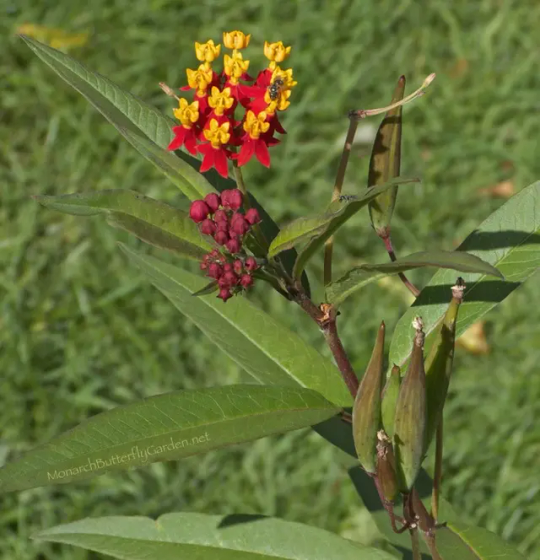
Step Two: Cut back seed pods! You would not believe how many seed pods milkweed makes. You see those little green footballs? You wanna snip these back ASAP. Even if they're tiny, but especially if they're bit. In peak flower production times, I'll go out there at least once a week and just do a look-back and cut them off. You can even yoink them off with your hands if you're in a rush--just don't get that sap into your eyes. If you do this, you're stopping seed production in its tracks--and don't forget, these plants want nothing more than to split those pods open and unleash a hellfire of flying seeds all over the place. They'll float on air, they'll float on water, they'll do whatever until they land on a prime patch of soil and get started.
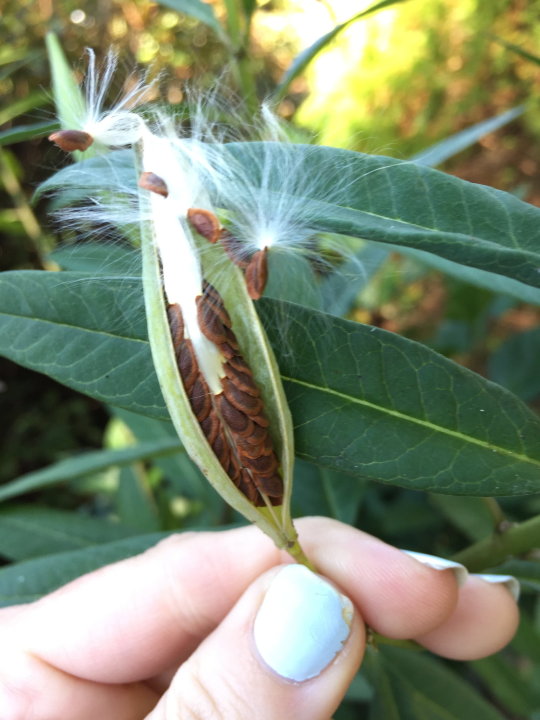
If you see these you're a tinge too late. But also still yoink that off and Dispose of it.
Step 3: Don't give cuttings to your friends. It's tempting. If you're raising caterpillars in a little enclosure and see that every time you refresh your cuttings, the old ones have tons of roots and are ready for a little pot of soil and a name tag? Don't. Resist the best you can. Dispose of your cuttings whenever you go in for a trim.
Step 4: Consider replacing them with something else! I know I already went off about just how hard it was to find native milkweeds for sale, how expensive and difficult they can be to grow--but they're not impossible to grow, and putting in the effort could be worth it! Even as I speak, I'm trying to add as many native milkweeds to my garden as possible--and when I've got something that grows reliably in my backyard, I will eagerly rip up my aging tropical milkweed plants and promptly toss them in the bin so i can put a new, better milkweed in its place. Native milkweeds are more likely to be suited to your environment, making it easier to maintain and more welcoming to the pollinators we gardeners want to help. Not to mention, a lot of them are way pettier than tropical milkweed (in my opinion). Do some hunting online to see what's native to your area--your state's extensions office will likely be great for this! You've likely got great variety--the state of Florida has 21 native milkweeds! Who knows how many your state has! (Not me, I am Floridian, and I am already getting dizzy trying to learn about all 21 of our milkweeds).
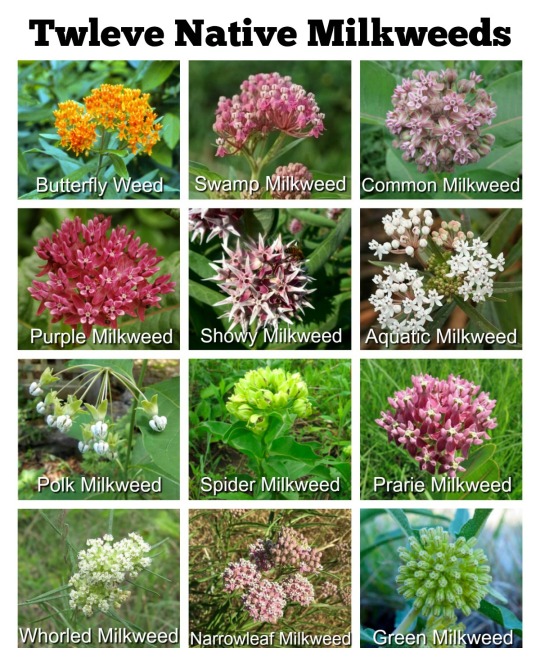
Conclusion!
Anyone who knows me knows I'm not gonna be the one to discourage someone from starting a garden, especially a pollinator gardener, and especially growing milkweed. But avoid tropical milkweed when you can--the harms it can cause far outweigh the quick satisfaction of a busy garden it can bring. Take some time to select a native plant more suited to your area, give it some friends and some time, and soon you'll have an amazing pollinator garden that'll be teeming with life!
#milkweed#tropical milkweed#asclepias curassavica#asclepias#outdoor gardening#succulents#bloodflower#pollinator garden#pollinator gardening#monarch butterfly#ani rambles#out of queue#what was it three hours ago that I was declaring that I wasn't gonna write up a long research post again?#now here i am at 3:30 am ranting about milkweed with like a dozen sources#granted this is nowhere NEAR as long as the biodiversity saga was BUT STILL#i told myself i was gonna write today... i meant one of my novels NOT RANTING ABOUT MILKWEED#if this post blows up this is gonna go on my wall of 'posts that i thought of on the toilet that got way more popular than I expected'#there's not a lot of posts on that wall maybe 2 or 3 but its weird that its happened that many times already
250 notes
·
View notes
Text




“Kunlun looked at him, almost lovingly and tenderly. He thought regretfully, it’s too bad I won’t be able to see the small beauty grow into a big beauty.”
#zhu yilong#he’s just a smol baobei#朱一龙#he’s so beautiful I wanna cry#please stand by for the queue#my gifs#镇魂 guardian#沈巍#镇魂#Shen Wei#black robe envoy#朱一龍#주일룡#This man played three different roles in this drama and he looks completely different as every one…the range 10/10#zhenhun
144 notes
·
View notes
Text
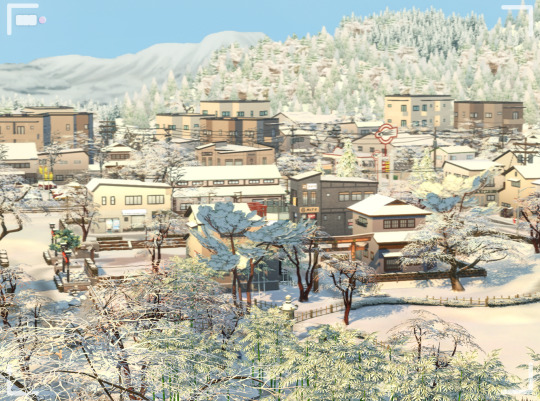

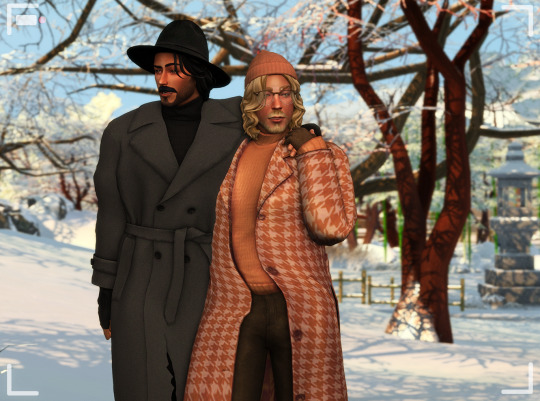


Kiss Me in Komorebi+ 🌸
[ Third Vacation: Maxwell! ]
As part of my incessant need to mix things up, Maxwell won the Background Luck Roll (thank you, random.org) that earned him a special mini moment with Daniel! The two saw the sun glittering off the snow in the early morning and decided that it would be the perfect weather for a nice, relaxing stroll.
Part 4 of 7 🌹
@yikessims
#ts4#ts4 screenshots#ts4 gameplay#ts4 challenge#ts4 bachelor challenge#;kmik#sim: daniel#maxwell santiago by yikessims#||#these were meant to post yesterday but my queue keeps messing up 😖#so all three parts of this little special moment are going up today!!#maxwell and dan look so good together bwah 🥹#i’m boutta start takin them poly comments serious bc i can’t handle him not being with every single one of them pfff#they all are starting to get more serious and involved and i’m NOT READY#NOT READY for the next rose ceremony omg#i hope you are all doing well! 🥹🙏#thank you for continuing to read kmik and follow dan along on his journey!!#🙏🙏🙏
59 notes
·
View notes
Text
i can make a tumblr roleplay blog i can talk to any mutual i want as long as their dms are open i could roleplay i could have a fun little chat i am not rendered helpless because of anxiety i can do whatever i want <- lying to itself
#this is going in the queue. we’ll see when it comes out#anyway three notes and i will try one (1) tumblr rp. six notes and i will try another. <- this post is gonna flop so hard#ten notes and i will talk to three (3) random mutuals. if we get to twenty i will continuously roleplay on tumblr#thirty notes and i will talk to a mutual once a week.#coming up with goals that i won’t have to meet is equally fun and depressing <3#i talk
52 notes
·
View notes